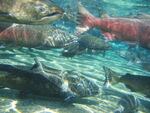About 200 miles of the West Coast will be closed to ocean salmon fishing this year to protect a record-low run of Klamath River chinook.
Fishery managers with the Pacific Fishery Management Council voted Tuesday for a total closure of ocean salmon seasons from southern Oregon to northern California.
Commercial troll fishing seasons will be closed from Florence, Oregon, to Horse Mountain, which is south of Eureka, California. Sport fishing seasons will be closed from Humbug Mountain south of Port Orford, Oregon, to Horse Mountain in northern California. The rest of the coast will have limited fishing seasons.

Fall chinook. Fishery managers closed ocean salmon seasons on about 200 miles of coastline in Oregon and California in 2017.
Pacific Northwest National Laboratory/Flickr
West Coast salmon runs have been hit hard in recent years by drought conditions in their native rivers and El Niño conditions in the Pacific Ocean that reduce their food sources.
While fishermen up and down the coast are in for a tough year, those who depend on Klamath River salmon are already calling for help. Fishing groups and Native American tribes plan to ask California Gov. Jerry Brown to declare a fishing disaster so they can receive federal assistance.
The salmon returns for other Oregon streams and the Columbia River look healthier than the Klamath, according to state reports. And Washington is expecting average to good chinook returns for Puget Sound salmon and other coastal rivers. However, some Washington coho salmon stocks are expected to have low returns, and that triggers restrictions on other salmon fisheries.
The north coast of Oregon and Washington will have minimal seasons that are a little better than last year, according to Butch Smith, who chairs an advisory panel that helps the council set salmon seasons.
Smith said the fishing seasons from Florence, Oregon, to San Francisco are so grim they will likely qualify for fishing disaster assistance. Managers were only able to allow fisheries in that whole region to catch about 800 Klamath River fish to protect what is projected to be smallest run ever of Klamath River fall chinook.
"All those coastal communities can only impact 800 fish. That is a pretty devastating thing," Smith said. "They could be right back there again next year, too."
Managers are expecting to see less than 12,000 Chinook salmon returning to the Klamath River this year, which means tribes that fish on the river will also be severely limited in how many fish they can catch.
Thomas Wilson of the 6,100-member Yurok Tribe said the allocation for his tribe of 650 fish is by far the lowest they've ever received. That will force the tribe to cancel its commercial fishing season for the second year in a row.
"This is about one fish for every 10 Yurok people," Wilson told members of the Pacific Fishery Management Council. "That's not enough for us to live. The Yurok people people are fishing people. It's our identity. Without fish we are nothing. We cease to exist."
He called on fishery managers to work together to heal the Klamath River.
Fish advocates blame a lack of water releases from dams for the low returns of Klamath River salmon. Earlier this year, a judge ordered the U.S. Bureau of Reclamation to increase water flows in the hopes of flushing out a salmon-killing parasite that infected 90 percent of juvenile salmon in the river in 2015.
“When you lose 90 percent of your fish population through juvenile disease, we're seeing the effects of that now,” said Karuk Tribal Councilman Joshua Saxon.
Saxon says the Klamath salmon returns are so low, the Karuk tribe is restricting its ceremonial and subsistence fishing for the first time ever. The 3,600-member tribe will only catch 200 fish this year.
"Two hundred fish is really not even enough for ceremonial purposes, so this is really beyond a minimal number of fish," Saxon said. "This is not an amount that is going to feed hardly anyone."
Saxon said the unprecedented restrictions will have social and economic consequences for the tribe, which has been fishing in the same Klamath River pools for thousands of years.
Related: Shielded Native American Cultural Sites Thrust Into Debate Over NW Dams
"It's affected us to the core," he said. "We have a relationship with our river that's stronger than anything else that we have."
While dams, low water flows and disease have gravely harmed the fish, Saxon said, he still has hope that the plans to remove dams on the river will go forward and improve conditions for salmon.
PacifiCorp is awaiting approval from the Federal Energy Regulatory Commission on a plan to remove its four Klamath River dams by 2020.
"We can't give up," Saxon said. "This river needs to be managed for fish. Taking care of the fish disease problem upriver close to the dams is our number one priority."
